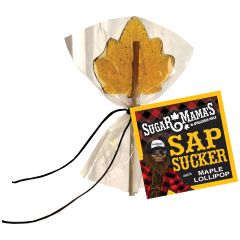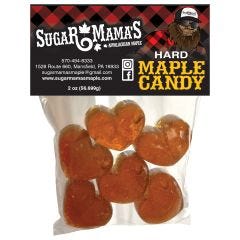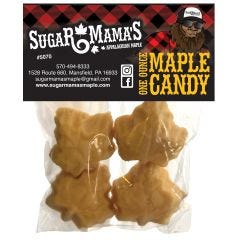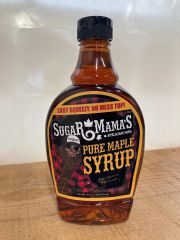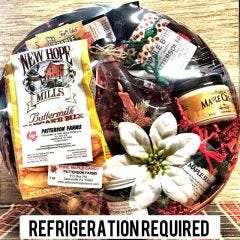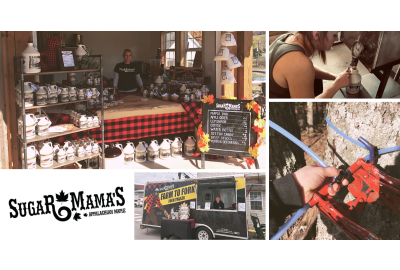Maple syrup and other maple products are a big part of Pennsylvania’s agricultural economy… and it sure is sweet to get an inside look at how those products are made, both by big companies and by small producers at their own homes!
According to the PA Department of Agriculture, Pennsylvania produced 178,000 gallons in 2020, 168,000 gallons in 2021 and 164,000 gallons in 2022. That’s just from the approximately 250 producers that sell the product on the market, including some here on the PA Wilds Marketplace!
Buy real maple products on the PA Wilds Marketplace!
The PA Wilds Marketplace currently has two maple producers: Sugar Mama’s Appalachian Maple and Patterson Farms. Check out their products at here on the PA Wilds Marketplace!
A maple educational program at Parker Dam
I was fortunate enough to be able to attend an educational program at Parker Dam State Park in Clearfield County along the I-80 Frontier landscape of the PA Wilds earlier in March 2024.
Eric Rensel, Parker Dam State Park Natural Resource Specialist, led the free program to teach attendees about the history of maple syrup, how it’s been made historically, how technology has advanced, try some hands-on activities, and even get a taste of locally made syrup!


Eric, assisted by Jeremiah Irvin (an Environmental Interpretive Technician at Parker Dam), started the educational program with legends and lore of how indigenous people first discovered maple sap and boiled it down into syrup. He made sure that everyone knew the difference between sap and syrup, and he talked about how and why maple trees make sap to begin with. Attendees learned about which kinds of trees produce the best kind of sap to make into syrup and how to tell which trees were healthy enough to be tapped.
Maple production is also very dependent on weather. In order for sap to start flowing, the temperature needs to be below freezing at night but warm up to above freezing (to about the mid 40s) during the day. The average window for these perfect conditions usually happens in February or March, but it can be difficult to predict. Maple producers have anywhere from about 1.5 months to even just a few days during a bad season. Eric estimates they usually average about three weeks for the typical maple sugaring season at Parker Dam. Maple producers want to collect sap before the trees start to produce leaves and the sap turns into a bitter “buddy” flavor.
Hands-on activities kept the many kids in attendance entertained and engaged. Eric passed around wood wafers when talking about how capillaries pull sap through the tree, and attendees were encouraged to hold the wafers up to the sunlight to see how the wood wasn’t completely solid. Blocks of maple sugar were passed around too… and, although Eric warned everyone that those blocks had been in the hands of hundreds of other people throughout years of doing the educational program, some curious kids still sneakily licked the block.


For another hands-on activity, a bucket of sap was set next to a bucket of water for folks to examine the differences between the two. Lastly, a refractometer was gently passed from person to person so everyone could peek through the lens and check the sugar content of a sample of sap.
Eric led us from the sugar shack itself up a small hill and into the woods, where dozens of trees were tapped and leaking sap into either buckets that hung on the tree or directly into plastic lines that fed into the sap tank behind the shack. Eric and Jeremiah explained how this plastic tubing revolutionized the maple industry, cutting down on some of the hard work for producers to lug heavy buckets to their sugar shacks.
During this particular maple syrup educational program, Eric was able to tap a new tree to show our group how it was done. He warned that this doesn’t always happen, especially later in the season when it might not be worth it to tap a tree, but we were happy to see the process. Together, our group identified a maple tree that was large enough to bear a tap and didn’t already have a bucket hanging from it this year. We looked for previous tap holes, then chose a new spot. Eric got the manual drill started, and each kid took a turn using all their might to twist the manual drill a couple of times until it was deep enough. Eric used a mallet to thunk the tap into place, and the sap began to flow immediately.


Everyone in attendance was invited to see for themselves what heavy labor gathering the maple sap could be! Folks were asked to, if possible, grab one of the buckets from where they were hanging from the tree, bring it to a small tank, help Jeremiah dump it in, then take the empty bucket back to the same tree they collected it from. It was hard work, especially since some of the buckets were filled to the brim with sap. Participants had to walk carefully to avoid spilling the sap, and the heavier buckets were given to adults instead of the kids.


After working up a sweat collecting the sap, attendees walked back down to the sugar shack to learn how the sap would be boiled down. Eric went over some of the historical techniques of boiling the sap to reduce the water content and turn it into syrup, then continued onto some of the more high-tech equipment that you’ll see in modern sugar shacks.
Even when the sap is boiled down to sticky syrup, the work isn’t done! Syrup is then filtered to remove grainy particles and make it look more clear. Depending on when during the season the sap is collected, the maple syrup can have a variety of colors and flavors, ranging from golden or amber to very dark.
The kids were starting to get excited to get a taste of the sweet maple syrup for themselves. Beforehand though, Eric paused to read a poem, “Sap Time,” by Albert B. Southwick.


The city man drives past and sees the sap pails on the trees.
He stops his car and steps outside and sniffs the fragrant breeze.
He sees the happy farmers with their maple trees on tap.
He breathes a sigh of envy but he’s never gathered sap.
-- The beginning lines of “Sap Time”
Finally it was time to taste the syrup. Eric handed out small paper cups, and he filled up a dispenser with some syrup that had already been produced and packaged. He poured a small amount into each waiting participant’s cup, encouraging them to take their time and appreciate the flavors that came from the trees around them.
For some young kids, it was their first real experience with true 100 percent maple syrup… and they were spoiled for life, never to be satisfied with the cheaper corn syrup imitation ever again.
Real maple syrup, they learned, is something special. Worth the effort, worth the price, and worth the wait.


Want to experience the joys of maple syrup for yourself? Check out the Potter-Tioga Maple Weekend!
The Maple Weekend is a “traveling festival” throughout Potter and Tioga County that allows visitors to observe tree tapping, sugar boiling, and other maple-related activities. Be sure to visit several sugar shacks from different businesses, as each is unique in production and variety of products. In 2024, the 20th Annual Potter-Tioga Maple Weekend is March 16 and 17, from 10 a.m. to 4 p.m. each day.
You can see the full schedule for 2024 here and more info about the event at pamaple.com.





